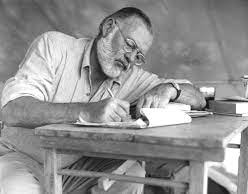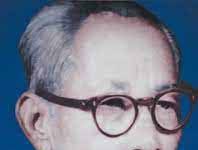Ernest Hemingway-Brief Biography
Ernest Hemingway
Ernest Hemingway-Brief Biography
Ernest Hemingway was a man with a multi-facet career in the twentieth-century world — he was a fisherman, a boxer, a hunter, a heroic participant in both world wars, a suffering lover, a worldwide traveler, and above all a Nobel Prize-winning writer who wrote short story and novel on those themes in which he had a share in his practical life. Moreover, it is to note well that he was the most suffered writer-both physically and mentally- of the twentieth-century world who made an end to his suffering life by committing suicide.
This man of many-facet careers, Ernest Hemingway was born on July 21, 1899, at Oak Park, Illinois in America. His father Clarence Edmunds Hemingway was a doctor in the profession. He had a deep interest in fishing and hunting. His mother had talent both in music and painting. Ernest Hemingway was the second child of his parents. During Ernest’s childhood, there had often a tussle between his father and mother over the future of Hemingway. His mother wanted him to devote himself to music while his father wanted him to develop his outdoor interests. The battle seemed, later on, to have been successfully won by his father who gave Ernest his first fishing rod when he was three years old and when he was eleven his father gave him a shot-gun.
As time began to pass, Ernest Hemingway seemed to be interested in outdoor life. He spent much of his early days roaming about in the woods, with a rifle on his shoulder, or rowing out across the water with a fishing hook in his hand in quest of big Fish. Although Hemingway had a cottage beside a lake, he usually slept outside in a tent which was kept lit with a kerosene lantern, and there at night, he spent many hours reading.
In the proper age of childhood, Ernest Hemingway was sent to school at Oak Park. As a student, he was not so good not so bad as he took an active interest in school athletics and football. During his last two years at school, he started writing in the school magazine. Miss Dixons and Miss Fannie Biggs, two of his schoolmistresses, encouraged him to go on writing stories and essays giving emphasis on originality.
At the age of eighteen, Hemingway graduated from Oak Park High School. Meanwhile, the war had broken out in Europe. Hemingway, after leaving school, did not like to sit idle at home so he wanted to enlist himself in the army, but he was too young and his eye-sight was poor to get admission in the army. So, being frustrated, he went away to Kansas City, where one of his uncles lived, and there took a job as a newspaper reporter. He liked the writing job but he could not drive away his desire to get into the army. There, in Kansas, he spent some months as a reporter for the newspaper, ‘The Star’. The style sheet of ‘The Star’ taught him to use short sentence, short paragraphs, vigorous English, and more taught him to be negative in his outlook. He hardly had spent seven months there as a newspaper reporter, till he met an opportunity to enlist himself as an ambulance driver in Italy. So in early 1918, he gave up his job as a newspaper reporter and joined the Red Cross Voluntary ambulance driver. Once he volunteered for canteen service and was riding a bicycle, handing out mail, tobacco and chocolate to soldiers in the trenches. On his tenth day in Italy, as he was handing a chocolate bar to a soldier, a large mortar shell fell nearby. He was almost buried. His body was filled below the waist with over 250 pieces of shrapnel, but after regaining consciousness, he rescued a badly wounded Italian soldier and while was turning to others then he was hit again, with a machine gun bullet. Thus he was very badly wounded there and was admitted to a hospital. He spent several months in a Red Cross Hospital and there he fell in love with an English nurse called Agnes von Kurowski. For his bravery in Europe during wartime, he received several medals as —’Croce de Guerra’ with three citations and the ‘Medaglia d’ Argento al Valore Militare’, the second-highest Italian military decoration. Then he was sent home, limping on a cane. He returned home being a different person from the inexperienced young Hemingway to an experienced Hemingway taking experiences of war, death, sufferance, love, and more taking experiences of new people, a new language within a short period of time.
After, returning home, Hemingway spent only a few days taking rest till his feet and legs healed. But while he seemed to be healed, he spent his hours reading and meditating. Still coming home, Hemingway kept up a correspondence with Agnes, with whom he fell in love at the Red Cross Hospital in Italy. But suddenly, one day he received a letter from her, which had broken his heart. He then retired into seclusion and for days he hardly left his room. On being repeatedly asked by his family, he revealed the matter of the letter that it had come from Agnes who wrote in the letter that she had married an Italian Army major.
Being betrayed in love by Agnes, Hemingway spent some days in a melancholic mood, but at last, he determined to forget Agnes and decided to pursue a work interesting to him. So after his will, he set off to Paris to study and to make a living by writing. There he met and became friendly with Gertrude Stein, Ezra Pound, James Joyce and some others. There he wrote something and sent them to the newspaper editors, but all his writings came back from the editors, being rejected without a single word of encouragement. Hemingway’s heart broke down and became frustrated. One day he was sitting at a sidewalk café on the left bank in Paris complaining to a friend about his ill luck as a writer as no editor accepted his writings. Observing Hemingway’s writing, his friend said to him that the main cause for which his writing was not accepted by any publishers was perhaps, his writing is lack in the portrayal of human suffering and misery. His friend’s advice made Hemingway conscious of human sufferance and misery and wrote out a novel entitled ‘A Farewell to Arms’ on the theme of love, war and sufferance that he experienced during his life in the Italian Red Cross Army. This novel proved an immediate success and got popularity. Within only four months as many as 80,000 copies of this novel were sold. This novel made him famous and by it, he could draw public attention as a prolific novelist.
After being rejected by Agnes, Hemingway married Hadley Richardson in 1920, at the age of twenty-one. In 1923 Hadley gave birth to his first son. In Paris, Hemingway met a dark-haired attractive girl who was a fashion writer. Hemingway fell in love with her, The name of that girl was Pauline Peiffer. In 1927, he married Pauline making an end to his first marriage.
With the publication of his novel ‘A Farewell to Arms’ his reputation as a novelist was established and his name was spread far and wide. In 1929, as he had a good interest in fishing, got his first giant martin weighing 468 Ibs. He wrote a book on bullfighting named ‘Death in the Afternoon’. In 1934 he took a trip to Africa and wrote ‘Green Hills of Africa’. In 1935, he went to Bimini for fishing and in 1936 he returned from Bimini when the civil war in Spain broke out.
Then he went to Spain, where he felt greatly attracted by bullfighting and spent several years in that country and took the job of a reporter on Spain’s civil war for American Newspapers. By this time, he was known as ‘papa’ a bearded huge figure of a man. During his days in Spain he wrote two books ‘The Fifth Column’ and ‘For Whom the Bell Tools’.
In Spain, Hemingway met Martha Gellhorn, a woman of the real brain and attractive beauty who was also a reporter for the ‘Colliers Magazines’. Hemingway and Martha faced the danger of covering the various battlefronts together. Martha interviewed Hemingway in Key West and subsequently, they fall in love with each other. Hemingway’s second wife Pauline, when came to know Hemingway’s love for Martha, went to Paris and brought Hemingway back to America, but Hemingway could not resist his attraction towards Martha. Moreover, Hemingway had a personal grudge against Pauline for having destroyed his first marriage with Hadley. As a result, Hemingway divorced Pauline and in 1940 he married Martha, who became his third wife.
In 1944, Ernest Hemingway flew away with the Royal Air Force to England as a correspondent with the Royal Air Force to spot the flying bomb launching sites and destroy them. During this World War II, his relations with Martha Gillhorn deteriorated because she was extremely ambitious and Hemingway had a deep-rooted suspicion of ambitious women. During wartime, Hemingway fell ill in Paris and Martha was called for attending to Hemingway but she had a certain grudge against him and so she did not go to see him. In Paris, he was attended upon by another woman named Mary Walsh who eventually became his fourth wife.
After then, Ernest Hemingway took traveling to Africa with his wife Martha. In Africa he met with two air crashes in course of two days and his obituaries were published in all the leading papers of the world. He read them with relish. On his return to Nairobi, he could get some medical assistance. There, he showed his wife all the good places he had known but he had to cut his trip short because of the accident. Mary was hurt badly and Hemingway had his spine jammed. His eyesight became poor and since then he had been feeling complaints of injured kidneys for the rest of his life. In warfare alone, he was shot through nine parts of his body and sustained six hand wounds.
Then, Ernest Hemingway, day by day began to feel bone-tired and restless and became more emotional. It is here, to say that Hemingway had built his abode in Cuba, where he had procured all his best belongings such as — his pictures, his books and memories. But with the rise of Fidel Castro in Cuba, the Americans were asked to leave Cuba. Then Hemingway broke down mentally as his good treasures were there and even he loved Cuba the best. In the meantime, he published a novel ‘Across the River and Into the Trees’ which was harshly treated by the critics. During this period he was completely obsessed with the thought of death and how to meet with it. With his disturbed mind and tired body he wrote and published another novel ‘The Old Man and the Sea’ in 1952 which was acclaimed as his masterpiece throughout the world. It bought him the Pulitzer Prize in 1953, and in 1954, he was awarded the Nobel Prize for literature — which raised his heart for some time; but the gathering gloom seemed to crush him down. Then he was admitted to Mayo Clinic where he received electric shocks for psychological troubles. He developed a double personality in the presence of doctors and behaved like a normal being but as soon as his doctors left him and he became alone the old troubles began to afflict him.
At last, Ernest Hemingway lost his mental balance being tired both the body and mind and so on 2nd July 1961, he took his gun in his hand and shot himself to death and thus the life of Hemingway, the multi-faced man of career and a worldwide famous novelist, came to an end.
Ernest Hemingway wrote always on those themes in which he had a share in his practical life. His writings are the picture of the human struggle against nature and human suffering on earth with perfect skill. His novels are autobiographical in theme though they are not written in the autobiographical style. He gave rise to a vigorous and spontaneous but plain prose which became a good model of imitation for many after him. In his descriptive prose, he was conscious of minute but realistic details. The structure of his novel is coherent and strong. His style is concrete, emphatic as the rain of bullets, largely monosyllabic and rich in the use of connective conjunction ‘and’. Though there is little morality in his writings yet his novels teach us to endure sufferance in life. Here, it is to say that whatsoever he wrote, he wrote with much care and devotion. It is known that he wrote, rewrote and revised the opening sentence of his masterpiece ‘The Old Man and the Sea’ more than two thousand times. 0 0 0
Ernest Hemingway
N.B. The article ‘Ernest Hemingway-Brief Biography’ originally belongs to the book ‘The World Writers-Brief Biographies‘ by Menonim Menonimus.
Ernest Hemingway
Books of Composition by M. Menonimus:
- Advertisement Writing
- Amplification Writing
- Note Making
- Paragraph Writing
- Notice Writing
- Passage Comprehension
- The Art of Poster Writing
- The Art of Letter Writing
- Report Writing
- Story Writing
- Substance Writing
- School Essays Part-I
- School Essays Part-II
- School English Grammar Part-I
- School English Grammar Part-II..
Books of S. Story by M. Menonimus:
Related Search:
- Lives of Poets
- Writers’ Lives
- Top Hundred Writers
- Best Writers of All Time
- Most Eminent English Poets











